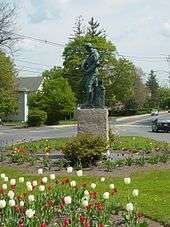Meta Vaux Warrick Fuller
| Meta Vaux Warrick Fuller | |
|---|---|
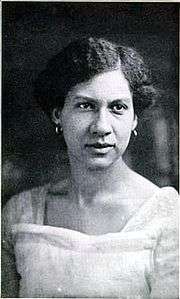 Meta Vaux Warrick Fuller in 1910 | |
| Born |
Meta Vaux Warrick June 9, 1877 Philadelphia, Pennsylvania, U.S. |
| Died |
March 18, 1968 (aged 90) Framingham, Massachusetts, U.S. |
| Education | University of the Arts, College of Art and Design, Académie Colarossi, École des Beaux-Arts |
| Occupation | Sculpture, Painting, Poetry |
| Movement | Harlem Renaissance |
| Spouse(s) | Dr. Solomon Carter Fuller (1909–1953) |
Meta Vaux Warrick Fuller (/ˈmiːtə
Early life
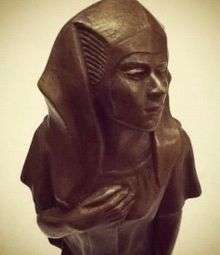
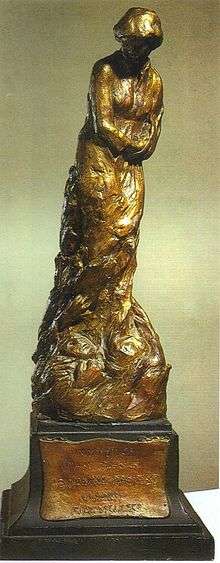
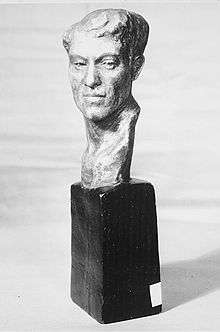
Meta Vaux Warrick was born in Philadelphia, Pennsylvania in 1877.[3] Her parents were Emma (née Jones) Warrick, a beautician, and William H. Warrick, a barber, both considered influential positions in African-American society. Barbers especially often had powerful white clients. She was named after Meta Vaux, the daughter of Senator Richard Vaux, one of her mother's customers.[4]
Philadelphia's large black community had become well-established and was socially and intellectually active. Warrick trained in art, music, dance and horseback riding. The city's rich cultural resources helped middle-class black society to prosper. Education, cultural enrichment, and social activity were encouraged and expected in Warrick's family. She was among the few selected from the Philadelphia public schools to attend J. Liberty Tadd's art school.[3] In the early 20th century, thousands of rural blacks came from the South in the Great Migration, stimulating the growth of numerous black organizations and institutions.
Warrick's art education and art influences began at home, as her father was interested in sculpture and painting.[4] Her older sister, who later became a beautician like their mother, had an interest in art and kept clay that Meta was able to play with. Her brother and grandfather entertained and fascinated her with endless horror stories. These influences partly shaped her sculpture, as she eventually developed as an internationally trained artist known as "the sculptor of horrors."[5]
Education
Warrick's career as an artist began after one of her high-school projects was chosen to be included in the 1893 World's Columbian Exposition in Chicago. Based upon this work, she won a scholarship to the Pennsylvania Museum and School of Industrial Art (PMSIA) (now The University of the Arts College of Art and Design) in 1894,[6] where her gift for sculpture emerged. Unwilling to limit herself to traditionally "feminine" themes, she occasionally sculpted pieces influenced by the gruesome imagery of fin de siecle Symbolist literature and painting — a choice that represented a rare act of independence by a woman artist.[7] In 1898, she received her diploma and teacher's certificate.[7]
Upon graduation in 1899, Warrick traveled to Paris, France, where she studied with Raphaël Collin,[6][7] working at sculpture at the Académie Colarossi and drawing at the École des Beaux-Arts. Warrick had to deal with racial discrimination at the American Women's Club, where she was refused lodging although she had made reservations before arriving in the city. African-American painter Henry Ossawa Tanner, a family friend, found lodging for her and introduced her to his circle of friends.
Warrick's work grew stronger in Paris, where she studied until 1902. Influenced by the conceptual realism of Auguste Rodin, she became so adept at depicting the spirituality of human suffering that the French press named her "the delicate sculptor of horrors." In 1902, she became the protege of Rodin. Of her plaster sketch entitled Man Eating His Heart, Rodin remarked, "My child, you are a sculptor; you have the sense of form in your fingers."
Career
Warrick created works of the African-American experience that were revolutionary. They represented art, nature, religion and nation. She is considered part of the Harlem Renaissance, a flourishing in New York of African Americans making art of various genres, literature, plays and poetry. The Danforth Museum, which has a large collection of her works, states that Fuller is "generally considered one of the first African-American female sculptors of importance." [6]
Paris
In Paris, she met American sociologist W.E.B. DuBois, who became a lifelong friend and confidant. He encouraged Warrick to draw from African and African-American themes in her work. She met French sculptor Auguste Rodin, who encouraged her sculpting.[8] Her real mentor was Henry Ossawa Tanner while learning from Raphaël Collin.[9] By the end of her time in Paris, she was widely known and had had her works exhibited in many galleries.[10]
Samuel Bing, patron of Aubrey Beardsley, Mary Cassatt, and Henri de Toulouse-Lautrec, recognized her abilities by sponsoring a one-woman exhibition including Siegfried Bing's Salon de l'Art Nouveau (Maison de l'Art Nouveau).[11][12] In 1903, just before Warrick returned to the United States, two of her works, The Wretched and The Impenitent Thief, were exhibited at the Paris Salon.
United States
Returning to Philadelphia in 1903, Warrick was shunned by members of the Philadelphia art scene because of her race and because her art was considered "domestic." She exhibited at the Pennsylvania Academy of the Fine Arts in Philadelphia in 1906, which was a center of art in the city.[13] However, this treatment did not prevent Fuller from becoming the first African-American woman to receive a U.S. government commission: she created a series of tableaux depicting African-American historical events for the Jamestown Tercentennial Exposition, held in Norfolk, Virginia in 1907.[14] The display included fourteen dioramas and 130 painted plaster figures depicting scenes such as slaves arriving in Virginia in 1617 and the home lives of black peoples.[15]
Warrick exhibited again at the Pennsylvania Academy of the Fine Arts in 1908. In 1910, a fire at a warehouse in Philadelphia, where she kept tools and stored numerous paintings and sculptures, destroyed her belongings; she lost 16 years' worth of work. The losses were emotionally devastating for her.[2] At that point she was financially dependent upon her husband, socially detached from African-American contacts, and desolate about her career.
Exhibitions
1907 Jamestown Tercentennial
In February 1907, Warrick secured a contract to create fourteen dioramas depicting the African American experience. At the time, it was described as the "Historic Tableaux of the Negroes' Progress." Historian W. Fitzhugh Brundage has described Fuller's tableaux as one which suggested "the expansiveness of black abilities, aspirations and experiences, [presenting] a cogent alternative to white representations of history."[16] Warrick's tableaux were given prominent display in the Negro Building at the Jamestown Tercentennial where they occupied 15,000 square feet.[16] Each scene consisted of painted plaster figures and extensive painted backdrops. The 14 tableaux depicted the following: the landing of the first slaves at Jamestown; slaves at work in a cotton field; a fugitive slave in hiding; a gathering of the first African Methodist Episcopal Church; a slave defending his owner's home during the Civil War; newly freed slaves building their own home; an independent black farmer, builder and contractor; a black businessman and banker; scenes inside a modern African American home, church and school; and finally, a college commencement. For her work on the tableaux, Warrick was awarded a gold medal by the directors of the exposition.[14]
Other exhibitions
Fuller exhibited at the Pennsylvania Academy of the Fine Arts in 1920. She created one of her most famous works, Ethiopia, for America's Making Exhibition in 1921. This event was meant to highlight immigrants' contributions to US artistic society and culture. This sculpture was featured in the exhibition's "colored section," and it symbolized a new black identity that was emerging through the Harlem Renaissance. It represented the pride of African Americans in African and black heritage and identity.[17]
In 1922, Fuller showed her sculpture work at the Boston Public Library. Her work was included in an exhibition for the Tanner League, held in the studios of Dunbar High School in Washington, D.C. The federal commissions kept her employed, but she did not receive as much encouragement in the US as she had in Paris. Fuller continued to exhibit her work until her last show (1961) at Howard University (Washington, D.C.) in 1961.[15]
Meta Vaux Warrick Fuller died on March 13, 1968, at Cardinal Cushing Hospital in Framingham, Massachusetts.[5]
Marriage and family
In 1907, Warrick married Dr. Solomon Carter Fuller, a prominent physician.[2] Of Liberian birth, Dr. Fuller was one of the first black psychiatrists in the United States. When they married, he was on staff in the pathology department at Westborough State Hospital in Westborough, Massachusetts. The couple settled in Framingham, Massachusetts, in 1910 and had three sons together.[6][18]
White neighbors resented the black family. They tried to remove them via petition and isolated them from neighborhood affairs. Warrick left her church after having been subject to racial bigotry of the parishioners. Dr. Fuller died in 1953.[15][18] Their son Robert Fuller worked for a time as a teacher at Framingham High School.
After the fire, Warrick Fuller built a studio in the back of her house, something which her husband strongly opposed. Between domestic duties, she sculpted traditional religious scenes. She retained her interest in such works although she left the church after she and her family were discriminated against by neighbors and parishioners.[18] Although busy with her family, Fuller also worked steadily on her sculptures.[6]
Posthumous appreciation
Warrick Fuller's work has received new interest since the late 20th century. Her work was featured in 1988 in a traveling exhibition at the Crocker Art Museum, along with artists Aaron Douglas, Palmer C. Hayden and James Van Der Zee.[19] Her work was also featured in a traveling exhibition called Three Generations of African American Women Sculptors: A Study in Paradox, in Georgia in 1998.[20]
The Danforth Museum has a large collection of Fuller's sculptures. Many were exhibited in a solo retrospective show of her work from November 2008 to May 2009.[6]
Poetry
Her poem "Departure" was included in the 1991 collection, Now is Your Time! The African-American Struggle for Freedom.[21]
- The time is near (reluctance laid aside)
- I see the barque afloat upon the ebbing tide
- While on the shores my friends and loved ones stand.
- I wave to them a cheerful parting hand,
- Then take my place with Charon at the helm,
- And turn and wave again to them.
- Oh, may the voyage not be arduous nor long,
- But echoing with chant and joyful song,
- May I behold with reverence and grace,
- The wondrous vision of the Master's face.
Works
- Bacchante, painted plaster sculpture, 1930[22]
- Ethiopia, bronze sculpture, greenish-black patina, c. 1930[22]
- Ethiopia Awakening, bronze sculpture, 1910[23]
- Emancipation, in plaster, 1913; in bronze, 1999.[24] Featured on the Boston Women's Heritage Trail.[25]
- Henry Gilbert, painted plaster sculpture, 1928[22]
- Jason, painted plaster sculpture, Danfort Museum[6][22]
- Les Miserables, bronze sculpture, Maryhill Museum of Art, Goldendale, Washington[22]
- Lazy Bones in the Shade, sculpture, c. 1937[22]
- Man Eating Out His Heart, painted plaster sculpture, 1905-1906. It represents a kneeling male nude eating his heart.[22]
- Mary Turner (A Silent Protest Against Mob Violence), painted plaster sculpture, 1919, Museum of Afro-American History, Boston, Massachusetts[22]
- Mother and Child, cast bronze sculpture, 1962, Massachusetts Institute of Technology[22]
- Phyllis Wheatley (c. 1753-1784), painted plaster sculpture, c. 1925. It was made based upon an engraving published in 1773[22]
- Refugee, sculpture, c. 1940. Hunched male figure with a cane in his hand[22]
- Talking Skull, bronze sculpture, 1937, Museum of Afro-American History, Boston, Massachusetts. Kneeling male figure facing a skull[22]
- The Good Shepherd, painted plaster sculpture, c. 1926-1927[22]
- Waterboy, sculpture, 1930[22]
Legacy
A woman of deep religious faith, Fuller created at least one piece of religious art annually. At various times, she was a literary sculptor, at others a creator of portrait art - which she studied under Charles Grafly at the Pennsylvania Academy of the Fine Arts. Although she said that she could not specialize in African-American types, Fuller became one of the most effective chroniclers of the black experience within the United States.[26]
Fuller is known for sculpture that depicts crises and sadness of African-American life. These include: Ethiopia Awakening (1914), Mary Turner: A Silent Protest Against Mob Violence (1919), and Talking Skull (1937). Ethiopia Awakening, drawn from Egyptian sculptural concepts, is an academic sculpture of an African woman emerging from a mummy's wrappings, like a chrysalis from a cocoon, represented her statement on black consciousness in Africa and in the United States.
Mary Turner was her response to the lynching of a young, pregnant black woman in Lowndes County, Georgia. Her contemporary, Angelina Weld Grimké, wrote the short story "Goldie" based on this murder.[27] [28]
Talking Skull explored issues of life and death within the context of an African folktale.
Awards and honors
Fuller received numerous awards for her work.
See also
- Associates
- Contemporaries
References
- ↑ "American National Biography Online: Fuller, Meta Vaux Warrick". www.anb.org. Retrieved 2017-03-11.
- 1 2 3 Arna Alexander Bontemps and Jacqueline Fonvielle-Bontemps (eds.), eds. (2001). "African-American Women Artists: An Historical Perspective". Black Feminist Cultural Criticism. Keyworks in Cultural Studies. Malden, Massachusetts: Blackwell. pp. 133–137. ISBN 0631222391. The editors compare Warrick with her contemporary, May Howard Jackson, another African-American sculptor from Philadelphia, who was also born in 1877.
- 1 2 Kerr, Judith Nina (1 January 1986), God-Given Work: The Life and Times of Sculptor Meta Vaux Warrick Fuller, 1877-1968 Pennsylvania, Proquest, AAI8701179
- 1 2 Sicherman, Barbara; Green, Carol Hurd (1980), Notable American Women: The Modern Period; a Biographical Dictionary, Harvard University Press, p. 255, ISBN 978-0-674-62733-8
- 1 2 West, Sandra L. (2003), "Fuller, Meta V. Warrick", Encyclopedia of the Harlem Renaissance, New York: Facts On File, retrieved 28 March 2014
- 1 2 3 4 5 6 7 Meta Warrick Fuller : Sculptures from the Studio. Danforth Museum of Art. 11 May 2014.
- 1 2 3 Leininger-Miller, Theresa A. (2001), New Negro Artists in Paris: African American Painters and Sculptors in the City of Light, 1922-1934, Rutgers University Press, p. 9
- ↑ "Fuller, Meta Warrick (1877-1968) | The Black Past: Remembered and Reclaimed". www.blackpast.org. Retrieved 2017-11-09.
- ↑ "How is Meta Vaux Warrick Fuller's "Ethiopia Awakening" a symbol of the Harlem Renaissance?". ThoughtCo. Retrieved 2017-11-09.
- ↑ A Harlem Showcase for Black Art, New York Times, Associated Press, 1923, p. C25
- ↑ "Meta Vaux Warrick Fuller". Bridgewater State College Hall of Black Achievement. 2005-11-17. Archived from the original on 2009-07-24. Retrieved 2008-03-30.
- ↑ Thorp, Nigel (2007-05-08). "Siegfried Bing, 1838-1905". The James McNeill Whistler project at the University of Glasgow. Archived from the original on 2008-01-02. Retrieved 2008-03-30.
- ↑ Manning, Patrick (2009). The African Diaspora: A History Through Culture. New York: Columbia University Press. p. 211. ISBN 978-0-231-14471-1.
- 1 2 "The Industrial History of the Negro Race of the United States". Archive.org. 1908. Retrieved 13 April 2018.
- 1 2 3 "Meta V.W. Fuller, sculptor of Black themes". The African-American Registry. 2005-06-09. Archived from the original on 2008-03-17. Retrieved 2008-03-29.
- 1 2 Brundage, W. Fitzhugh (March 2003). "Meta Warrick's 1907 'Negro Tableaux' and (Re)presenting African American Historical Memory". The Journal of American History. 89 (4): 1368–1400.
- ↑ Ater, Renée (2003). "Making History: Meta Warrick Fuller's "Ethiopia"". American Art. 17 (3): 12–31. JSTOR 1215807.
- 1 2 3 "Meta Vaux Warrick Fuller (1877-1968)". Uncrowned Queens. Archived from the original on 2010-05-28. Retrieved 2008-03-30.
- ↑ Van Proyen, Mark (1988). "Trail Blazers in Harlem". Artweek. 19 (1).
- ↑ Wilson, H.W. (1998). "African American Women Sculptors". American Art Review. 10: 162–165.
- ↑ Walter Dean Myers, Now Is Your Time! The African-American Struggle for Freedom, 1991
- 1 2 3 4 5 6 7 8 9 10 11 12 13 14 Meta Warrick Fuller. SIRIS database search. Smithsonian Institution. Retrieved 11 May 2014.
- ↑ "Fuller, Meta Warrick (1877-1968) | The Black Past: Remembered and Reclaimed". www.blackpast.org. Retrieved 2017-11-09.
- ↑ "Emancipation » Public Art Boston". www.publicartboston.com. Retrieved 2016-04-01.
- ↑ "South End". Boston Women's Heritage Trail.
- ↑ Crisis, XXXII, 6 (October, 1926), 246.
- ↑ Herron, Carolivia (1991)"The Introduction", to The Selected Works of Angelina Weld Grimké
- ↑ Armstrong, Julie Buckner (2008). "The People... Took Exception to Her Remarks': Meta Warrick Fuller, Angelina Weld Grimke, and the Lynching of Mary Turner". The Mississippi Quarterly.
Further reading
- 250 years of Afro-American Art: An Annotated Bibliography by Lynn Moody Igoe with James Igoe. New York: Bowker, 1981
- An Independent Woman: The Life and Art of Meta Warrick Fuller (1877-1968). Framingham, MA: Danforth Museum of Art. 1984. Exhibition catalogue.
- Renée Ater. Remaking Race and History: The Sculpture of Meta Warrick Fuller. Berkeley: University of California Press. 2011. ISBN 9780520262126
- Mary Schmidt Campbell, Harlem Renaissance: Art of Black America (1994)
- Kathy A. Perkins. "The Genius of Meta Warrick Fuller," Black American Literature Forum. 1990. 24:1. pp. 65–72. Focuses on Fuller's designs for theater.
- Richard J. Powell and David A. Bailey. Rhapsodies in Black: Art of the Harlem Renaissance (1997)
